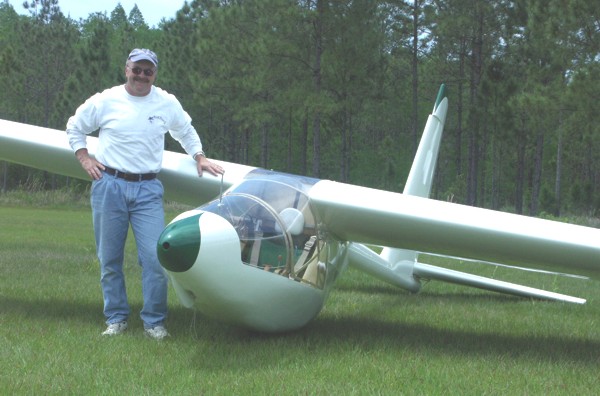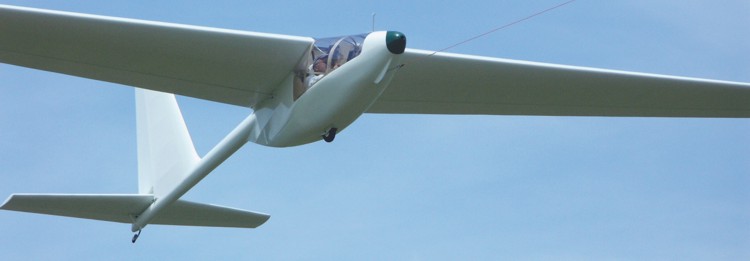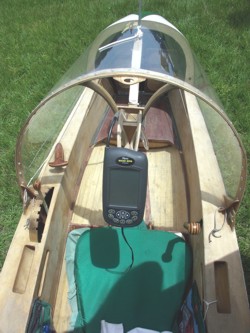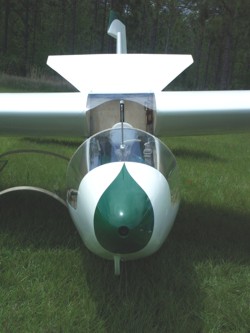
There’s not one quite like it-Steve Arndt’s lightweight Carbon Dragon, that is. Arndt (pictured next to his ultralight sailplane-Magic Dragon) flies his glider from Florida’s Wallaby Ranch Flight Park.

The Magic Dragon’s light weight makes it ideal for use at airparks that offer towing services to hang glider pilots. Here, an American Tug tows the Magic Dragon aloft during a visit to Wallaby Ranch.

The Magic Dragon cockpit uses a wood
finish, even including the lever knobs,
contrasted with a high-tech electronic digital soaring instrument.

Underneath the glider’s speed brake, note that a whole airframe, balistically deployed parachute has been installed.
There’s only one Carbon Dragon currently flying; it belongs to Steve Arndt, who calls his beautiful version of this ultralight sailplane the Magic Dragon. What he can do with it is indeed quite magical.
On a day when experienced hang glider pilots were only getting in short, half-hour soaring flights at Florida’s well-known Wallaby Ranch Flight Park, Arndt appeared to be gearing up for an entire afternoon of soaring.
“Oh, he’ll be up 3 hours, and we won’t see him until he decides to come back for dinner,” said Wallaby Ranch proprietor Malcolm Jones. Such is the nature of flying the unusually lightweight Carbon Dragon. Most soaring pilots would agree that Arndt’s sailplane and his flying are both remarkable.
An Ultralight Glider
Designed by a team led by the late Jim Maupin and Irv Culver, the Carbon Dragon has a 44-foot wingspan with full-span flaperons, an empty weight of 145 pounds and a gross weight of 335 pounds. Performance is a primary goal of such a soaring aircraft, and the Carbon Dragon can achieve a maximum glide ratio of about 25:1. The glider is built of plywood with carbon fiber used throughout to increase strength; thus the name Carbon Dragon.
Five of them have been built, yet all but Arndt’s are either currently down for maintenance or have been retired from service. Arndt is a longtime hang glider pilot with 26 years of experience. He took sailplane lessons a few years ago and has earned his private glider license. He’s also a builder.
“My original intention was to design and build the highest performing hang glider ever,” Arndt said. “But the more I researched and considered the options, the more the Carbon Dragon seemed to be really what I wanted.”
However, this ultralight glider was not made for all pilots. “I was too heavy at 185 pounds, and the prototype was too fragile and subject to weather degradation,” Arndt admitted. So he revised his plan and decided to build a better Carbon Dragon—the Magic Dragon—without sacrificing the performance capabilities of the gliders that had been completed earlier.
After talking with friends in the Sailplane Homebuilders Association and reading about various construction techniques, Arndt decided to combine the previous efforts with some new ideas. After three years of effort, Arndt test flew his Magic Dragon in June 1999.
“My glider is considerably different than the prototype,” Arndt explained. “It gets its spar strength from the use of carbon rods integrated with an all-composite leading-edge D-tube. There are many additional composite parts both internal and external. It has been load tested to 5 Gs based on a pilot weight of 185 pounds and including the weight of a ballistically deployed parachute.” Additional changes were made to reduce fuselage drag and optimize the Maupin/Culver design.
The Magic of
The real magic of the Carbon Dragon is that it can maintain an incredible sink rate within the turning radius of a hang glider. Doing so, the aircraft accomplishes a feat impossible for heavier, faster conventional sailplanes—the ability to exploit smaller thermals. With its large control surfaces including full-span flaperons, the Magic Dragon can maneuver with ease in the smallest thermals producing mere wisps of lift.
“You can really feel the texture of the airmass better than any aircraft I’ve ever flown,” Arndt reports. Significantly aiding the ultralight glider’s mission, he says, are the Carbon Dragon’s forgiving stall characteristics.
The airfoil shape is varied across the span and may be adjusted in flight by changing the flaperon settings. Specifically, Arndt’s Magic Dragon has two reflex settings that raise the flaperons above the neutral position to allow faster speeds. In addition, the flaperons can be set at four levels of conventional downward deployment. The efficiency of the flaperons is further improved by the differential mixer and enhanced by the addition of winglets, which Arndt believes improve tip efficiency particularly at low speed and in turning flight. These design features give the pilot a variable wing that has a speed range wide enough for cross-country flight while allowing confident flight close to terrain as well as exploration of very light lift.
The use of carbon fiber yields an image of a high-tech aircraft, when in fact the majority of the glider is made of wood and fabric. I particularly liked Arndt’s use of wood to form his flap lever notches and the knobs of all his control levers. In fact, I liked the entire cockpit interior.
Since he’s a hang glider pilot, Arndt employs the latest in soaring instruments widely used in the hang gliding community. These devices are tiny all-digital instruments supplying a wide range of information in a compact battery-powered housing. It made for a fascinating contrast to his all-wood cockpit.
I watched as Arndt was towed aloft behind a new ultralight tug called the American Tug; this aircraft easily launched the Magic Dragon due to its light weight, making the ultralight glider a logical aircraft to use at numerous airparks that offer towing services to hang glider pilots. Its speed and thermal-circling flight qualities are also compatible with modern hang gliders.
According to Arndt, “Building it has been a most rewarding experience exceeded only by the great joy of flying it.”
Do You Believe
In the past, builders like Arndt purchased plans from Jim Maupin, Ltd. However, the family running this operation has since ceased selling plans. Fortunately, another enterprise has stepped into this void—Sirius Aviation. According to its web site, the company is currently reviewing the plans to develop preliminary pricing for materials, but there are no plans in the works for a kit.
At present, the plans-and-materials company estimates that a complete materials list for the Carbon Dragon may cost about $3700. That and 1200 loving hours, and perhaps you could have your own Carbon Dragon. And it could become only the second flying example in the world. How’s that for a truly special project?
FOR MORE INFORMATION, contact Sirius Aviation at 214/457-1760; web www.sirius-aviation.com.
To review all “Light Stuff” columns that have appeared in KITPLANES®, visit www.ByDanJohnson.com, which links to the KITPLANES® web site with articles of interest.
| Seating | 1 |
| Empty weight | 145 pounds |
| Gross weight | 335 pounds |
| Wingspan | 44 feet |
| Wing area | 153 square feet |
| Wing loading | 2.2 pounds/square foot |
| Length | 19.2 feet |
| Height | 5.7 feet |
| Build time | 1,200 hours |
| Stall Speed | 19 mph |
| Never exceed speed | 65 mph |
| Min Sink Rate | 100 fpm at 26 mph |
| Glide Ratio | 25:1 at 35 mph |


I would love to build one.